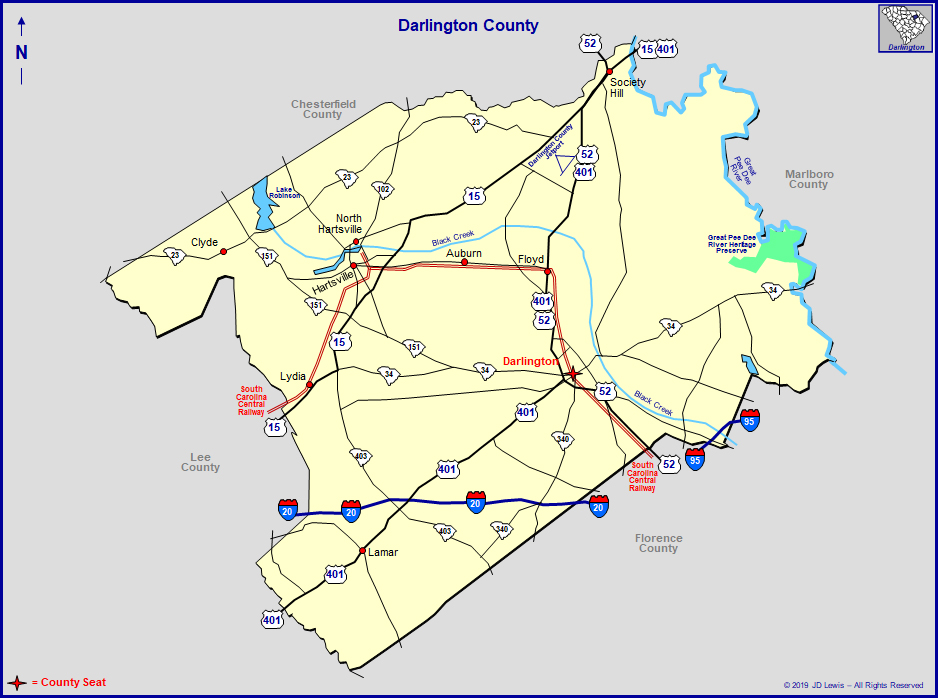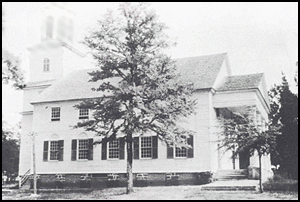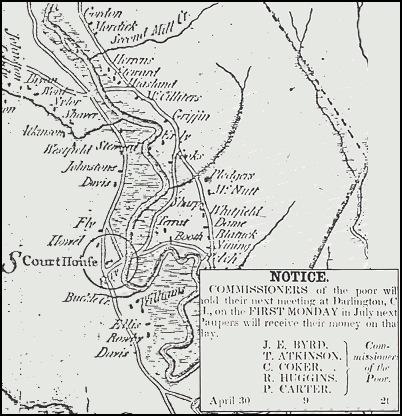 |
||||
|
|
||||
|
|
|
|
|
|
|
|
|
|
|
|
|
|
|
|
|
|
|
|

|
|
|
|
|
|
|
|
|
|
|
|
|
|
|
|
|
|
|
|
|
|
|||
 Welsh Neck Baptist Church - Built in 1777 The origin of the name of this county is uncertain, but it may have been named for Darlington, England. The county was formed in 1785, with the county seat at Darlington, and until 1800 it was a part of the Cheraws District. Parts of Darlington County were removed to form Florence County in 1888 and Lee County in 1902. This area was settled in the mid-eighteenth century by Welsh, Scots-Irish, and English farmers, who grew cotton primarily. In more recent years the county has been best known for the stock car races which take place at the Darlington Raceway. David Rogerson Williams (1776-1830), governor and scientific experimenter, was a native of Darlington; he is remembered for introducing the mule to Southern agriculture. Other prominent Darlington residents were industrialists James Lide Coker (1837-1918) and David R. Coker (1870-1938), and novelists Annie Greene Nelson (1902-1993) and Elizabeth Boatwright Coker (1909-1993).  Cheraws District Map - c.1775 For nearly sixty, years after the first settlements at Charles Town, the area which is now Darlington County was a heavily timbered pine forestland, inhabited only by a few small Indian tribes, of whom the Cheraws were the most dominate. Until the early 1730s, no white man had attempted to establish a home this far into the backcountry along the upper Pee Dee River; one of the first of whom we have any record was one Murfee, who cleared a plantation on the Pee Dee River somewhere in the vicinity of what is known today as Pocket landing. He was soon joined by an influx of Welshmen from Pennsylvania and Delaware. In all effort to induce settlers to come to this area of South Carolina, the colonial government in 1736 and again in 1737, set aside two immense grants of land extending for miles along both sides of the Pee Dee River, for the exclusive use of the Welsh Baptist in Delaware who were contemplating removal to this Province - these were called the Welsh Tracts. The entire length of Darlington County bounding on Pee Dee River lies within the limits of these two old Royal Grants. The Welshmen came and started the nucleus of a new civilization in the wilderness, developing new institutions of their own, with little further aid or guidance from the Royal Government. At first, they congregated in the bend of the river opposite the present town of Society Hill, where they had founded the Baptist Church of Christ, at Welsh Neck in 1738. The surnames of those constituting this church were James, Devonald, Evans, Harry, Wilds, and Jones. From this bend in the river - called the Welsh Neck, the Welshmen cleared new lands up and down both sides of the river, first cultivating flax and hemp, later indigo, and raising cattle. Cheraw bacon was a popular item in the Charles Town markets of colonial days. During the several decades immediately prior to the American Revolution, the original Welsh domain was peacefully invaded by English, Scots-Irish, French Huguenot, and German Palatine settlers from other regions. From the inevitable intermarriages that followed, the strict Welsh Baptist identity was eventually lost. Darlington District (county), however, continued to be a stronghold of the Baptist denomination well into the nineteenth century. There were no churches of any other faith in the area until about 1789, when Methodist missionaries began to traverse the region seeking converts; their first foothold was in the present Lydia neighborhood, where one of the oldest Methodist churches in South Carolina was founded - Wesley Chapel or the "Gully Church." The first and only Presbyterian Church in the county for years was the Darlington Church, founded in 1827 by the Scots-Irish settlers from Marion and Williamsburg districts; the Episcopalians of Darlington District were only able to support one church - Trinity Church, Society Hill, founded 1833, for a quarter century until the second Episcopal Church was organized in 1859 near Mars Bluff. Other than several "Hard Shell" Baptist churches, weak and widely separated, no other denominations were represented in Darlington District until after the War Between the States. The first village in the entire area and for many, many years, the only village within what is now Darlington County, sprang up on a bluff on the west aide of Pee Dee River, across from the original settlements and church in the Welsh Neck. By 1760, this important trading post and boat landing had come to be known as Long Bluff. It was chosen as the site for the court house after the ovrer-arching Cheraws District was created in 1769. In this Court House, in 1774, a Petit Jury presentment of grievances against the British Crown is among the earliest and boldest declarations of rights in the thirteen colonies. Long Bluff continued to be the seat of justice and commerce throughout the tragic days of the American Revolution. Although the war inflicted severe casualties in lives and property, recovery was not unduly protracted, probably due to the natural increase in population plus the influx of many new settlers from North Carolina. In 1777, a group of prosperous planters of the area formed the St. David's Society to promote the cause of education; little was done during the war, but with the return of peace, a schoolhouse - St. David's Academy - was erected on the first hill beyond the river, about one mile from the village of Long Bluff; a few years later, the Welsh Neck Baptist Church removed from the east side of the river to a lot on the hill, adjacent to the academy. A new community began to grow up around the academy and the church, and was named Greeneville in honor of Major General Nathanael Greene of the Continental Army. The old village of Long Bluff was eventually abandoned in favor of the new village on the hill, which soon changed its name to Society Hill obviously in honor of the Academy of St. David's Society which dominated the hill. Society Hill, with its old, respected and influential Baptist Church; its Academy boasting tutors of the highest caliber; and its Library Society soon became the unchallenged cultural center of the Pee Dee region, a title it held for generations. In 1785, Darlington County was one of three counties created out of the old Cheraws District; after some controversy, the site of the court house of the new county was located on the plantation of John King, Sr. on Swift Creek, about the geographical center of the area. The court house was built a short distance south of the King residence at the intersection of two roads. Lots were laid off surrounding the court house by Josiah Cantey, Deputy Surveyor, but his plat has never been found. The village thus created was first known as Darlington Court House. By 1820, other villages had sprung up throughout the district: Mechanicsville, near the river, about ten miles below Society Hill on the road to Georgetown; Springville, more a summer resort than a village, but boasting an academy and a post office; and Kelley Town, not far from Black Creek in the northwestern portion of the district. Hartsville came into being as a village around Capt. Thomas E. Hart's Store and post office in the early 1840s; Lamar (then known as Mims' Cross Roads) grew around a crossroads store and post office on the Capt. George Mims' Plantation in the early 1850s. About the same time, Leavensworth came into being as a village, centering around John F. Wilson's store and grist mill, at an intersection near the center of his immense plantation, originally owned by Dr. Nathan Leavensworth. There was also a school; a U.S. Post Office; and a resident physician, Dr. John J. Wilson. In the late 1850s Dovesville (then Dove's Depot) grew around a Cheraw & Darlington Railroad depot built on the plantation of Daniel Dove soon after the tracks were laid across his land. With an ever-increasing acreage devoted to the planting of cotton, the overall wealth of the district grew considerably during the first half of the nineteenth century. As it was throughout the entire South, this cotton economy was vitally dependent upon the labor of the black man - the system of slavery - and the concentration of that class was heavy in Darlington County in the last decade prior to the war. The ratio of population as revealed by the United States Census of 1850 shows that whites were outnumbered by blacks nearly two to one. In the antebellum period, the wealth of the district was, for the most part, concentrated in the eastern half of the area, which was made up of numerous huge plantations, each an independent community within itself. With a few notable exceptions, the western portions of the district contained smaller and less prosperous plantations and farms, and fewer slaves. With agriculture having dominated the way of life in the district from the first settlements in the 1730s, it is not surprising that the planters of the area as early as 1768 organized a Planters Club about which little is now known; again, around the early 1840s another attempt was made to form Planters Society, but likewise no record exists concerning this group. On May 5, 1846, the Darlington District Agricultural Society was formed for the purpose of "promoting the planting interests" and is still active to this day, being the second oldest such group in the state and one of the oldest in the nation. The first officers of the Society were W.E. James, President; Rev. J.M. Timmons, Rev. Robert Campbell, and I.D. Wilson. There was a successful attempt at industrialization made as early as 1812 by one of Darlington's most colorful figures, Governor David Rogerson Williams. He established and operated during his lifetime a water-powered cotton mill on Cedar Creek near Society Hill for the manufacture of cotton bagging, oznaburgs, etc. It was first known as Cheraw Union Factory and later as Union Manufacturing Company of South Carolina. During the War Between the States, Darlington County escaped General William Tecumseh Sherman's torch, being out of the direct line of the Federal advance. There were no battles fought on her territory, and only several minor skirmishes. However, detachments of the main force did pass through the district by way of Kelley Town and New Market, confiscating supplies and livestock over a wide area. But, pioneer cabins and palatial antebellum mansions were left standing. In 1868, the name Darlington District (in use since 1785) was changed to Darlington County and provisions made for the township system of county government patterned after that of the New England states. The system was unsuitable for this region and never developed as originally intended. In 1888, Darlington County, one of the larger counties of the state, lost almost one third of its territory toward the formation of the new county of Florence; again, in 1901, it lost an additional fifty square miles of territory at the formation of the new county of Lee. From the time of Governor Williams' cotton factory, there was no further serious attempt at manufacturing of any nature until 1883, when a cotton mill was built in Darlington under the leadership of Major James Lide Coker. Within the following twenty years, Major Coker had also organized at Hartsville the Carolina Fibre Company and the Southern Novelty Company, both factories based on the conversion of southern pine into paper and paper products. Agriculture has, however, continued to be the mainstay of Darlington County until the present day; cotton was king until dethroned after World War I by flue-cured tobacco, which was introduced to Darlington planters in the late 1880s. Since World War II, the industrial growth of the county has been very favorable and promises to provide an alternative to the decline in agricultural pursuits which are expected in the next generation. Darlington County, organized in 1785, lying along the west bank of the Pee Dee River in the rich alluvial plain area of eastern South Carolina, was named, there is reason to believe, for the town of Darlington in England. Darlington, the county seat, had in 1920, 4,669 inhabitants, estimated 5,000 now; Hartsville, home of Coker college for women, 15 miles northwest, had 3,624, now estimated at 4,000; and Lamar had 784, now estimated 1,000. Of the county's population, estimated in 1925 at 40,882, 99-3/4 per cent were native born. While the white and colored races are absolutely distinct socially, their relations are friendly, they are united for progress, and Darlington County is proud that no lynching or attempted lynching has ever occurred within its borders. With an elevation about 150 feet above sealevel, the county's normal temperature is 62.5 ° and its average rainfall 49.5 inches. The average of days of sunshine is 264 in the year and the days between killing frosts are 225. Many small streams drain the region and pure water is easily obtained from them or by pumps or flowing wells. Natural conditions make it healthy. In 1777, wile the country was warring for independence, the St. David's Society was organized "to promote learning" and the spirit of the fathers has been handed down to flower in the excellent public schools. As early as 1776 the Welsh Neck Baptist Church was organized and substantial churches are found in all the towns and rural districts. Of the 605 square miles of alluvial soil fifty per cent is under cultivation and of this approximately seventy per cent is of Portsmouth and Norfolk sandy loam. Cotton, corn, small grain, and tobacco are the chief crops, but soil and climate permit successful growth of forage and grazing crops and truck crops of America, as well as growing of forage and grazing crops twelve months in the year, making conditions ideal for hog raising, dairying, and poultry production. Of the many farmers who have advanced agriculture, D. R. Coker, and E. McWilliamson are outstanding for the development, respectively, of upland long staple cotton and corn growing. The Darlington County Agriculture society, organized in 1846, has held annual meetings except possibly 1864-65. The Mutual Fire Insurance association, organized in 1890, with 300 members and $350,000 of property insured, now has about 1,000 members and $2,000,000 of property covered. Insurance cost is 33 cents as compared to former rates of $1.75 to $1.90. All losses have been promptly paid. Darlington men are the officers. Forest of pine, cypress, oak, hickory, gum, poplar, ash, and other woods, with railroads close, are a great source of wealth. Within the county, yarn, cloth, cotton seed products, fertilizers, wood pulp and paper, novelties, furniture, lumber, veneering, brick and tile, canned goods, flour, meal and grits, are manufactured. Labor is plentiful. There have been no strikes and electric power is available. The railway mileage is 116 and shippers are within twenty hours of the eastern markets. The county has 700 miles of well maintained highways and banking facilities are excellent in the trading centers. The white population are descendants of Welsh, Scotch, English, and French Hugenots. Immediately above, published in "South Carolina: A Handbook," prepared by The Department of Agriculture, Commerce, and Industries and Clemson College, Columbia, South Carolina, 1927. In the Public Domain. [with minor edits] |
|||
 |
 |
© 2021 - J.D. Lewis - PO Box 1188 - Little River, SC 29566 - All Rights Reserved